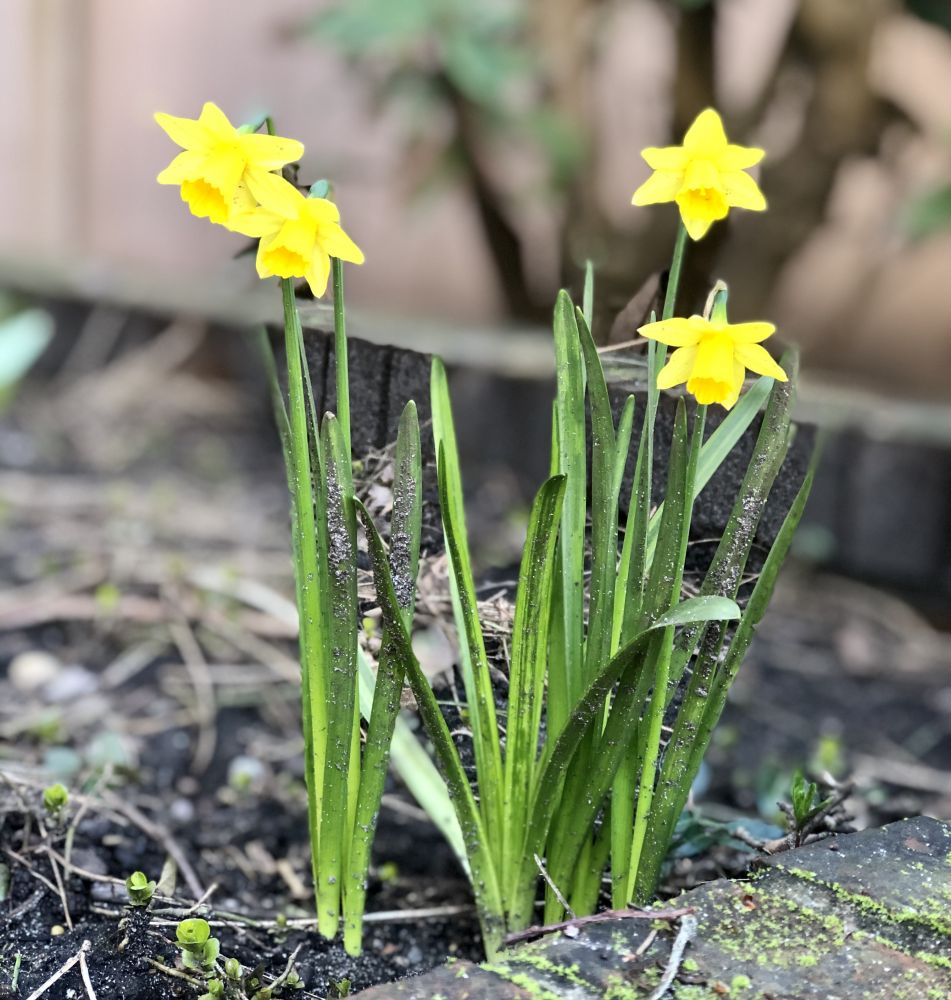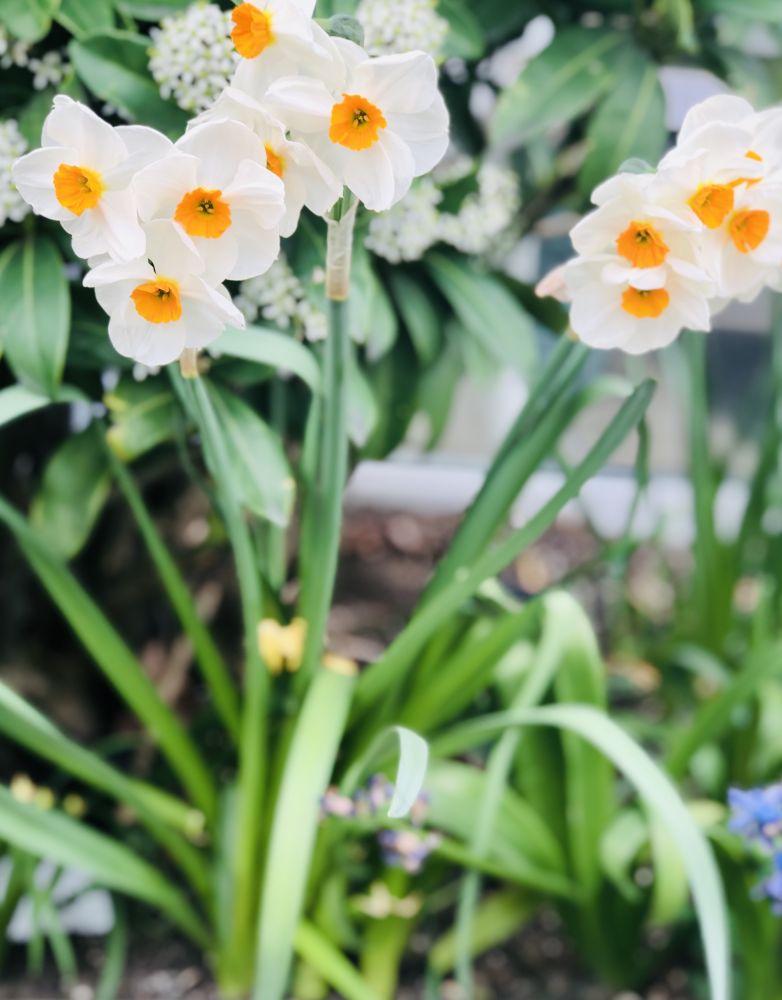如果你問福建人,什麽是他們最熟悉和喜愛的花呢?
絕大多數人的答案是:水仙花啊!
福建的漳州水仙花聞名全國,還遠銷到海外。每年春節前,福建人都要在室內擺上一盆水仙花。養水仙花不難,一個淺口瓷碗,一點清水即可,再擺上一些從河邊撿來的鵝卵石做裝飾。民間高手很多,總有人熱心地為你剝開水仙花的鱗莖皮,用薄而韌的刀片從外向裏雕刻,將每個花苞之間的皮都去掉一些。把刻好的鱗莖浸水三天,泡掉殘存的漿汁,然後再清洗幹淨擺在瓷碗裏,不時加點清水。

 (從其他網站下載的漳州水仙花圖片)
(從其他網站下載的漳州水仙花圖片)
幾天後,水仙的葉子長了出來,彎曲成各種造型。再後來就是花開時的心醉神迷,每支花箭上都有幾朵花,花型極美,六片潔白的花瓣,鵝黃的花杯,香味不絕如縷,難怪人們稱它為“金盞銀台”。
如果你是懶人,幹脆省了刀工,直接把鱗莖放在清水裏好了。沒有刻過的水仙的葉子朝上長,不開花時,外形和蒜似的,難怪有“水仙不開花-裝蒜”的說法。一旦花開,潔淨、淡雅、美好,自帶一番飄灑俊逸的氣質,又預示著吉祥如意。
我來加拿大後,發現這裏的水仙是成片種在土裏的,多為一莖一花,花朵比福建水仙大多了,非常奇麗,隻是不香。本地人稱水仙花為daffodil,而不是我在大學課本裏學到的narcissus。Daffodil還是加拿大癌症協會的標誌, 象征著希望。

 (加拿大常見的黃水仙)
(加拿大常見的黃水仙)
很顯然,溫哥華戶外隨處可見的水仙和福建水仙花並不是同一個品種。我在溫哥華生活了二十多年,一直沒有仔細研究過水仙。今春遭逢百年不遇的心冠病毒疫情,大多數人被迫在家上班,並且盡量減少外出。趁著難得的空閑,我重新拾起久違了的經典名著,在書香裏重溫水仙的芬芳。
一: 荷馬詩頌裏的水仙花傳說
歐洲關於水仙花的名字來曆的最古老的神話,並不是中國人熟知的納西索斯(Narcissus)的故事,而是出自公元前七世紀左右的《荷馬詩頌》(Homeric Hymns)。《荷馬詩頌》收納了33篇佚名作者寫的古希臘頌詩,每篇頌詩都歌頌一位古希臘神靈。這些作者采取了與《伊利亞特》、《奧德賽》同樣的史詩格律:抑揚六步格,並且使用了大量相同的範式和相同的方言,因此被貼上“荷馬”標簽。
書中的《致得墨忒耳》(To Demeter)篇,寫到主神宙斯和農業之神得墨忒耳的女兒珀耳塞福涅(Persephone)被冥王帝烏斯掠走為妻的情景:
“除了金色劍和光彩水果女神得墨忒耳,她還和俄刻阿諾斯(即河神)的大胸女兒一起玩,在柔軟的草地上采花,有玫瑰、番紅花、美麗的紫香堇,還有鳶尾花、風信子和水仙花 – 大地按照宙斯的意願生長著這些花,用來取悅萬眾之主,並作為如鮮花般盛開的妙齡姑娘的誘餌-一朵奇妙的、光彩的花朵。無論是永生的神靈還是凡人,這都是一件令人敬畏的事情:從它的根部長出一百朵花,聞起來最芬芳,使得整個天堂、整片大地和大海的鹽湧都開心大笑。 這個女孩驚呆了,伸出雙手去取這個可愛的玩具。但是寬闊的大地卻在尼薩平原上打了一個哈欠,萬眾之主騎著那匹不朽的駿馬奔向了她- 克羅諾斯的兒子,他有很多名字。 ”
(注:希臘人畏懼直呼冥王帝烏斯(即普魯托)的名字,隱晦地稱他為“萬眾之主” Host of Many)
(Apart from Demeter, lady of the golden sword and glorious fruits, she was playing with the deep-bosomed daughters of Oceanus and gathering flowers over a soft meadow, roses and crocuses and beautiful violets, irises also and hyacinths and the narcissus, which Earth made to grow at the will of Zeus and to please the Host of Many, to be a snare for the bloom-like girl — a marvellous, radiant flower. It was a thing of awe whether for deathless gods or mortal men to see: from its root grew a hundred blooms and it smelled most sweetly, so that all wide heaven above and the whole earth and the sea's salt swell laughed for joy. And the girl was amazed and reached out with both hands to take the lovely toy; but the wide-pathed earth yawned there in the plain of Nysa, and the lord, Host of Many, with his immortal horses sprang out upon her —the Son of Cronos, He who has many names. )


當傷心欲絕的得墨忒耳終於找到女兒時 ,女兒毫無保留地向母親訴說了自己的悲慘遭遇:“我們正在嬉戲,采集美好的鮮花,溫柔的番紅花夾雜著鳶尾和風信子,還有玫瑰花和百合花,美輪美奐,還有水仙花,寬廣的大地使它長成番紅花那樣的黃色。我興高采烈地采著,大地突然從下麵裂開,那強大的主人,萬眾之主一躍而出,坐在金色的戰車裏,把我擄到地下,盡管我極不情願:於是我尖叫、哭泣。這一切都是事實,即使說起還使我心痛。)
(we were playing and gathering sweet flowers in our hands, soft crocuses mingled with irises and hyacinths, and rose-blooms and lilies, marvellous to see, and the narcissus which the wide earth caused to grow yellow as a crocus. That I plucked in my joy; but the earth parted beneath, and there the strong lord, the Host of Many, sprang forth and in his golden chariot he bore me away, all unwilling, beneath the earth: then I cried with a shrill cry. All this is true, sore though it grieves me to tell the tale.)
不過這則神話在西方的流傳程度遠不如後來的美少年納西索斯的故事。


二)納西索斯與水仙花
最著名的納西索斯版本是古羅馬詩人奧維德(Oivd, 公元前43年 - 17年)創作的。《變形記》(Metamorphoses)是他最為人知的作品,他大約於公元2年開始寫這部作品,采用揚抑六步格的形式,完成於公元8年。全書有15冊,每冊大概700到900行,描述了羅馬和希臘神話中的世界曆史,其中總共包括了大約250個傳說。《變形記》是最受歡迎的神話作品之一,對中世紀的文學作品以及中世紀甚至到巴洛克時期的繪畫藝術有深遠的影響。
《變形記》第三卷中的納西索斯是全希臘最俊美的男子,但他對所有前來求愛的女人都無動於衷。女神厄科(Echo,“回聲”的意思)對他無比著迷,他也同樣加以拒絕。厄科傷心而死,隻餘聲音回蕩在山穀間。被拒絕的女子都要求複仇女神懲罰納西索斯。一次納西索斯在湖水中看到了自己的臉,瘋狂地愛上了自己的倒影,再也無法從湖邊離開。原文是這樣的:
“他(納西索斯)說著,瘋狂地回到相同的倒影中,他的眼淚攪動了湖水,倒影在蕩漾的水波中變得模糊不清。當他看到倒影消失時,大聲喊道:‘你飛往哪裏?留下來,殘忍的你,不要放棄一個愛你的人!我被允許凝視我無法觸摸的東西,饗宴我的悲愴熱情。’他哭泣時,淚水流到了衣服上,然後用大理石般精致的手捶打著赤裸的胸膛。他的胸部因雙手捶打而泛紅,就像半紅半白的蘋果,或似不同枝條上的葡萄串,因沒有成熟而沾染了一點紫色。
當他看到所有這一切都倒影在溶溶水波中時,再也忍受不了。就像黃色的蠟在微弱的火焰中熔化,像早晨的霜在陽光下消融,他也被愛削弱和融化了,被愛情的火焰一點點消磨。他不再擁有白裏透紅的美顏,不再擁有令人賞心悅目的生命和力量,也不再擁有厄科所鍾愛的身體。厄科看到這一切,盡管還在生氣和記著之前的事,但仍憐憫他。當那個男孩歎氣時,她也重複‘唉’,當他的手捶打肩膀時,她也回應同樣的痛苦的聲音。當他望著熟悉的水池說出最後一句話:‘哎,一切都是徒勞,心愛的男孩’時,每一個字句都在原地回蕩。當他說‘再見’時,厄科也說了‘再見!’
他將疲倦的頭埋在綠色的草地上,死亡閉上了那雙令造化驚歎的美麗的眼睛。
當他被送入地府後,仍注視著斯堤克斯河 (即環繞冥土的五條冥河之一)。他的水泉仙女姐妹們(Naiad,希臘神話中居住於溪水、泉水中並統轄這些水澤的仙女)為他悲慟,放下頭發,樹妖們(Dryad,希臘神話中的樹妖,通常以年輕美貌女子的形象出現)也悲痛不已。厄科重複著她們的哀悼。她們準備著葬禮的柴堆、火把和棺柩,但是屍體不見了。她們發現了一朵花,白色的花瓣環繞著黃色的心。”


(He spoke, and returned madly to the same reflection, and his tears stirred the water, and the image became obscured in the rippling pool. As he saw it vanishing, he cried out ‘ Where do you fly to? Stay, cruel one, do not abandon one who loves you! I am allowed to gaze at what I cannot touch, and so provide food for my miserable passion!’ While he weeps, he tears at the top of his clothes: then strikes his naked chest with hands of marble. His chest flushes red when they strike it, as apples are often pale in part, part red, or as grapes in their different bunches are stained with purple when they are not yet ripe.
As he sees all this reflected in the dissolving waves, he can bear it no longer, but as yellow wax melts in a light flame, as morning frost thaws in the sun, so he is weakened and melted by love, and worn away little by little by the hidden fire. He no longer retains his colour, the white mingled with red, no longer has life and strength, and that form so pleasing to look at, nor has he that body which Echo loved. Still, when she saw this, though angered and remembering, she pitied him, and as often as the poor boy said ‘Alas!’ she repeated with her echoing voice ‘Alas!’ and when his hands strike at his shoulders, she returns the same sounds of pain. His last words as he looked into the familiar pool were ‘Alas, in vain, beloved boy!’ and the place echoed every word, and when he said ‘Goodbye!’ Echo also said ‘Goodbye!’
He laid down his weary head in the green grass, death closing those eyes that had marvelled at their lord’s beauty.
And even when he had been received into the house of shadows, he gazed into the Stygian waters. His sisters the Naiads lamented, and let down their hair for their brother, and the Dryads lamented. Echo returned their laments. And now they were preparing the funeral pyre, the quivering torches and the bier, but there was no body. They came upon a flower, instead of his body, with white petals surrounding a yellow heart. )
與奧維德同一時期的神話學家科農(Conon,公元前63年 - 公元14年)也寫過一個關於納西索斯的故事:一個名叫阿美尼亞斯(Ameinias)的年輕人愛上了納西索斯,納西索斯拒絕了他,給了他一把劍。 阿美尼亞斯在納西索斯的家門口自殺了。自殺前,他向諸神祈禱,要把納西索斯給他的痛苦加倍奉還。某天納西索斯走到一潭清泉邊,準備喝點水。他看到了自己的倒影,深深地愛上了它,並為此感到絕望,相信自己因殘酷對待阿美尼亞斯而遭到天譴。他痛苦地自殺了,鮮血流到地上,化成了水仙花。


十九世紀末,埃及首都開羅附近的俄克喜林庫斯(Oxyrhynchus)地區發現了大量的紙莎草紙古文書,專家們一致致力於文物的翻譯和整理,並於2005年出版了相關書籍。其中的一張紙莎草紙上留有一首以詩歌的形式寫下的納西索斯神話,專家們認為這是希臘語文法家及詩人帕台尼烏斯(公元前72年 – 公元14年) 於公元前50年創作的。帕台尼烏斯又被後世學者稱為尼西亞的帕台尼烏斯(Parthenius of nicaea),曾經是古羅馬最著名的詩人維吉爾的希臘文老師。
如果推斷屬實,那麽帕台尼烏斯詩歌就是曆史上最早的納西索斯版本。 研究人員從莎草紙碎片上拚湊而成的詩歌譯文如下:
“… 神一樣的 …
他有一顆殘忍的心,討厭所有人,
直到他愛上了自己的模樣:
他哭了起來,看到自己的臉,如夢似幻,
在泉水潭裏,他為自己的美麗而哭泣。
然後少年身子裏的血流了出來,獻給大地
… 去承受”
(… god-like …
… …
He had a cruel heart, and hated all of them,
Till he conceived a love for his own form:
He wailed, seeing his face, delightful as a dream,
Within a spring; he wept for his beauty.
Then the boy shed his blood and give it to the earth
… to bear)
與科農的散文版本一樣,這首詩裏的納西索斯最終自殺,鮮血灑在了大地上。
生活在公元二世紀的羅馬時代的希臘地理學家和旅行家保薩尼亞斯(Pausanias,公元110年-180年)在著作《希臘誌》(Description of Greece)的第九章記述了納西索斯故事:
“在特斯皮埃地區有一個叫做多拿肯(Donacon,意為‘蘆葦床’)的地方。這裏有水仙泉。他們說納西索斯盯著水麵,卻不知道他看到的是自己的倒影,不知不覺地愛上了自己,並在那年的春天因愛憔悴而死。但這個說法太愚蠢了,一個成熟的能夠墜入愛河的男人竟然無法分辨真人和倒影。
還有一個關於水仙的故事,不如另一個故事流行,但比較靠譜。傳說納西索斯有一個雙胞胎妹妹,他倆的外表完全相同,一樣的頭發,穿著相似的衣服,一起狩獵。納西索斯愛上了妹妹,當女孩去世時,他來到了泉邊,清楚地知道他看到的是自己的倒影。盡管如此,他還是略感安慰,想象著看到的不是自己的倒影,而是妹妹的影子。


我認為,根據潘波(注:Pamphos,古希臘詩人,出生於荷馬之前)的詩來判斷,好多年前就有水仙花了。潘波比多拿肯的納西索斯早出生許多年,他說得墨忒耳的女兒在玩耍時被擄走了,用來做誘餌的花朵不是紫香堇,而是水仙花。”
(In the territory of the Thespians is a place called Donacon (Reed-bed). Here is the spring of Narcissus. They say that Narcissus looked into this water, and not understanding that he saw his own reflection, unconsciously fell in love with himself, and died of love at the spring. But it is utter stupidity to imagine that a man old enough to fall in love was incapable of distinguishing a man from a man's reflection.
There is another story about Narcissus, less popular indeed than the other, but not without some support. It is said that Narcissus had a twin sister; they were exactly alike in appearance, their hair was the same, they wore similar clothes, and went hunting together. The story goes on that Narcissus fell in love with his sister, and when the girl died, would go to the spring, knowing that it was his reflection that he saw, but in spite of this knowledge finding some relief for his love in imagining that he saw, not his own reflection, but the likeness of his sister.
The flower narcissus grew, in my opinion, before this, if we are to judge by the verses of Pamphos. This poet was born many years before Narcissus the Thespian, and he says that the Maid, the daughter of Demeter, was carried off when she was playing and gathering flowers, and that the flowers by which she was deceived into being carried off were not violets, but the narcissus.)
顯然,水仙花是美少年納西索斯死後變化而成的故事在古希臘後期就廣泛流傳了。奧維德版本是唯一將仙女厄科與納西索斯關聯在一起的。幾種版本裏的納西索斯的死法不同,但有一點是相同的:納西索斯死後,屍體不見了,化身為美麗的水仙花。但保薩尼亞斯似乎更偏向荷馬詩頌的說法,認為水仙花早在幾百年前就被稱作“narcissus”了,那時多拿肯的美少年納西索斯還沒有出生呢!


關於水仙花(Narcissus)名字的由來,還有一個更為世俗的解釋。古羅馬博物學家和作家老普林尼(Pliny, the elder,公元23年-79年)在著作《自然史》(Natural History)第21卷第75章提到:“有兩種水仙在醫學中使用,一種帶有紫色的花,另一種是草本水仙(注:被後世的瑞典植物學家林奈取名為Narcissus pseudonarcissus,即黃水仙)。最後,這對胃是有害的,它既起到催吐作用,又是瀉藥。它對肌腱也有害,並產生頭部麻痛:因此,它的名字源於“ narce”,而不是寓言故事裏的納西索斯。”
(Two varieties of the narcissus are employed in medicine, the one with a purple flower, and the herbaceous narcissus. This last is injurious to the stomach, and hence it is that it acts both as an emetic and as a purgative: it is prejudicial, also, to the sinews, and produces dull, heavy pains in the head: hence it is that it has received its name, from "narce," and not from the youth Narcissus, mentioned in fable.)
希臘語中的“ Narce”或“ narke”是“麻醉品”(narcotic)一詞的根源,意為“麻木、嗜睡”。古希臘人早就知道水仙花的鱗莖有毒,誤食後會出現惡心、嘔吐、腹痛、腹瀉等症狀。對於園丁來說,這是一個優點,水仙鱗莖不太可能遭到小動物的啃噬,容易種植。
附:
英格蘭最成功的拉斐爾前派畫家之一約翰·威廉姆·沃特豪斯(John William Waterhouse)於1903年創作的《厄科與納西索斯》(Echo and Narcissus)。除了水仙,畫麵上還有黃鳶尾花。

得墨忒耳與女兒珀耳塞福涅在開滿水仙花的原野上





